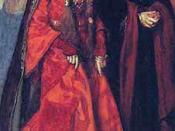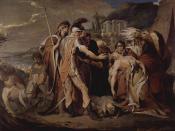One of the underlying themes in Shakespeare's play, King Lear is the concept of the generation gap. This gap is mainly illustrated between the family. The older generation is Lear himself, and the younger generation consists of his daughters Goneril, Regan and Cordelia. In the second plot of the play, Gloucester represents the older generation, and his sons, Edmund and Edgar exemplifies the younger generation. Both younger generations can be divided into two distinct groups. Goneril, Regan and Edmund are the villains in both the plots and Edgar and Cordelia are the loyal, faithful children. This little twist adds to the effect of the generation gap in the play. There are many comparisons that can be made and confrontations that occur between the generations. These events contribute to the themes of authority, power and loyalty, judgment and wisdom. Overall, it emphasizes the general themes of the generation gap.
Symbolism contributes to the themes authority and power in King Lear. These symbols are represented by material things. For example, in [Act 1 scene 1] when Lear is dividing up his land, power and authority to his three daughters, depending on how much they can verbally express their love for him. [Lines 52-53] 'Which of you shall say doth love us most? That we our largest bounty may extend where nature doth with merit challenge.' The land that each daughter received is the extent of their authority and of their power in the Kingdom. For example, the Duke of Burgundy did not wish to marry Cordelia after he found out she was getting nothing from her father. He was marrying her for power and authority.
Goneril's servants show disrespect toward Lear which shows that Lear's authority and power over them has diminished. An example of this is Oswald's...


